Overview
- Brief Narrative
- Patterned kimono and obi acquired by Sara Kupinski’s (later Cohen) family in Kobe, Japan, where her family fled using Japanese and Dutch transit visas supplied by diplomats in Soviet-occupied Kovno, (Kaunas), Lithuania. Sara lived outside of Lida, Poland (now Belarus) with her parents, Eliasz and Slawa, brother, Hirsz, and uncle, Samuel. Following Germany and the Soviet Union’s invasion of Poland in September 1939, Eli and Samuel fled to Vilna (now Vilnius, Lithuania) because they were considered wealthy landowners. Slawa, Hirsz, and Sara later joined them. Having obtained their transit visas in August 1940, Sara’s family left later that year, traveling on the Trans-Siberian railway from Moscow to Vladivostock. In early 1941, they took a boat to Kobe, Japan. That fall, they were forced to go to Japanese-controlled Shanghai. Samuel and Eli found work at a Jewish import and export company, and Sara and Hirsz attended the Jewish school. In early 1943, Japanese authorities ordered that all stateless refugees must live within a designated area, which came to be known as the Shanghai or Hongkew ghetto. In the summer of 1945, following the German surrender in May, US forces bombed Shanghai heavily. On August 14, Japan surrendered to the US. The Kupinski family learned that Slawa’s brothers had survived in France, but that her parents were killed in the Vilna ghetto in 1942 or 1943. Eli’s parents likely died in Siberia. In 1949, the family settled in Toronto, Canada.
- Date
-
acquired:
1941 February-1941 October
- Geography
-
acquired:
Kobe-shi (Japan)
en route: Shanghai (China)
en route: Canada
- Credit Line
- United States Holocaust Memorial Museum Collection, Gift of Lynda Cohen
- Contributor
-
Subject:
Sara Cohen
- Biography
-
Sara Kupinski (later Cohen, 1932- ?) was born in Vilna (Wilno), Poland (now Vilnius, Lithuania) to Eliasz (Eli, 1897-?) and Slawa (1902-?) Tsigelnitsky (Cegelnicki) Kupinski. Sara’s younger brother, Hirsz (b. 1933, later Hirsh Kupinsky), was born in Lida, Poland (now Belarus). Eli was born in Lida to Nathan and Lotte Kupinski, and had a brother named Samuel (1906-?.) Slawa was born to Pesach Tsigelnitsky and his first wife, who died shortly after Slawa’s birth. Slawa had an older brother, Chaim. Pesach later married Malka, his wife’s sister, and they had a son, Manya. The family lived in Vilna, and Pesach worked as a harness maker and saddler supplying Polish Cavalry units. Slawa completed her schooling and graduated from the local university. Later, Slawa married Eli. In March 1935, Eli, Samuel, and Jakob Radunski bought a large tract of land outside of Lida so they could ship lumber to England. They also sold milk and cheese to the Polish Air Force.
When Germany and the Soviet Union invaded Poland, in September 1939, the Kupinski family was living on Eli’s land. Though Vilna was returned to Lithuania, Lida and the surrounding area fell under Soviet control, becoming part of the Byelorussian Soviet Socialist Republic. As landowners, Eli and Samuel, were classified as wealthy capitalists and had to flee just after the invasion. They went to live with Slawa’s parents, Pesach and Malka, in Vilna. Later that fall, Slawa, Sara, and Hirsz were smuggled across the border and joined Eli and Samuel in Vilna.
On June 15, 1940, the Soviet Union invaded Lithuania, and later annexed it. Soviet exit visas were now required to escape from Europe via the eastern route to Asia, one of the two remaining ways for Jews to leave. In order to acquire an exit visa from Soviet-controlled Lithuania, Sara’s family needed two visas: a Japanese transit visa, and a visa for another country, money, and transport to continue on to that country. In summer 1940, Samuel and Eli travelled to Kovno (Kaunas), Lithuania. They pretended they were born in Warsaw, Poland, to secure a Soviet visa, as well as visas from Jan Zwartendijk of the Netherlands and Chiune (Senpo) Sugihara of Japan, two foreign consular officers in Kovno, who issued visas to many Polish refugees that summer. Sugihara issued more than 2,000 transit visas between July 11 and August 31, many with no formal authorization, even after being reprimanded by Japan for issuing them to people without proper papers or enough money to leave Japan. Sugihara continued issuing the visas, even to those that did not have the required Dutch portion, not ceasing his efforts until he was officially removed from Kovno in September. Zwartendijk issued permits stating that no visa was required for aliens entering Curaçao and other Dutch colonies. Samuel and Eli received the family’s visas on August 2. To reach those Dutch possessions, Sara’s family had to travel east via the Soviet Union and Japan. Sara’s maternal grandparents stayed in Vilna, and her paternal grandparents were likely transported to Siberia.
In late 1940, Sara’s family made their way to the Soviet Union, where they boarded an eastbound Trans-Siberian train in Moscow. They traveled for several cold months, crossing more than 5,000 miles of Siberia before arriving in Vladivostok in early 1941. From there, they boarded a ship to Kobe, Japan. Many refugees continued to other destinations, but Sara’s family was unable to do so because they could not secure a final destination visa to another country. The Dutch visa from Curaçao allowed them out of the Soviet Union and into Japan, but could not legally get them any further, and they became stranded. They stayed in the Yamamoto section of the city. The family spent time with other refugees living in and around the Foreign Settlement on the city’s outskirts. All of the Jewish refugees had long over stayed their transit visas, and were ordered to leave in August 1941. Sara’s family was among the last groups to be sent to Japanese-controlled Shanghai, China, arriving in early November.
In Shanghai, the Kupinski family moved into Hongkew, an industrial area of the International Settlement, and lived above two rabbis’ families in a boarding house for merchants. They did not go hungry, but had a restricted diet consisting of rice, noodles, tinned fish, sugar, potatoes, and bread. The Russian Jewish community in Shanghai was well established. Samuel and Eli were able find work with some members of this community, the Steinbergs, an older couple who ran an import and export company. Mrs. Steinberg enrolled Sara and Hirsz in the Kandorri School for Jewish children. The school was located in the French Concession, so Sara, Hirsz, and the other students were transported there by truck. Sara and Hirsz also spent time at a Jewish recreation club, Maccabi, which was strongly pro-Zionist, and joined the Betar youth group, which met weekly to discuss Jewish culture and Zionist objectives.
Following Japan’s December 7, attack on Pearl Harbor, Hawaii, Sara’s family and many others could no longer leave Shanghai for the United States, and they suffered food, clothing, and medicine shortages when American Jews could no longer send aid to Japan. In early 1943, under German pressure, Japanese authorities ordered that all stateless refugees, like the Kupinski family, must live within a designated area of the International Settlement, which came to be known as the Shanghai or Hongkew ghetto. Stateless refugees were not allowed to leave the area without permission, but Samuel and Eli were able to circumvent that restriction through their Russian connections. In May 1945, Germany surrendered, ending the war in Europe. That summer, US forces advanced on Japanese-occupied territory, and bombed Shanghai heavily. On August 14, Japan surrendered to the US. The Kupinski family learned that Slawa’s brothers had survived in France, but that her parents were killed in the Vilna ghetto in 1942 or 1943. Eli’s parents likely died in Siberia. On January 1, 1949, Sara, her family, and her uncle Samuel boarded the S.S. General M.C. Meigs in Shanghai, and sailed to San Francisco, California. They eventually settled in Toronto Canada. Sara later married a man from Newfoundland, and started a family. Sempo Sugihara and Jan Zwartendijk were honored as Righteous Among the Nations by Yad Vashem in 1984 and 1997 respectively.
Physical Details
- Classification
-
Clothing and Dress
- Category
-
Women's clothing
- Object Type
-
Kimonos (lcsh)
- Genre/Form
- Robes.
- Physical Description
- a. Long, black silk kimono with a colorful fan design hand-dyed (yūzen) on the lower half of the T-shaped body with a high, multi-part collar and long, trailing rectangular sleeves that are open along the inner seams. Several individual panels are sewn together along straight seams and the open front would be fastened closed with a wide waist sash (obi). Painted across the upper portion, there are five small circular, white crests (mon) with a stylized bamboo leaf pattern: two on the front and three on the back. The large, open folding fans (ougi) are painted around the lower half of the body, along the padded hem, and on the bottom of the sleeves. Each fan bears stylized, traditional decorative elements and overlaps with others across a red-orange lattice pattern (koushi) on a tan background with scalloped edges resembling clouds. Many flowers are scattered across the design, including cherry and plum blossoms, peonies, chrysanthemums, and paulowina. The fans also feature a crane, a phoenix, two drums, and three imperial carts (goshohur) as well as clouds, bamboo leaves, pine trees, pine needle bunches, and crashing waves. These elements are mixed in with repeating geometric patterns: hexagons mimicking tortoise shells, overlapping circular waves (seigaiha), and repeating circles representing seven jewels (shippo). On the interior, red silk lines the sleeves and upper body and the lower portion is black silk with a tan, curved, and scalloped band running across the width and a flowered fan at each end. The seams are pulling apart at the shoulders.
b. Long, rectangular obi or sash consisting of a single length of white silk fabric dyed red with patterns created using traditional Japanese resist dyeing (shibori) techniques. Along the full length of the sash is a wide, center band which has a red and white three-dimensional pattern formed by tying the cloth in small peaked bunches before dyeing (kanoko technique). Within the wide band, there is a scrollwork vine of solid red puckered cloth. Running along the full length of the center band are narrow, red, puckered bands. Along the outer edges of the sash are wider bands of large, loosely bunched fabric peaks with red tips and a red and white spider web pattern formed by tying thread around the cloth peaks prior to dying (tegumo technique). Near each end of the obi, the main design is broken by two vertical sets of three, parallel solid red puckered lines. The underside of the cloth is solid red and puckered where the front peaks have been pulled up. There are selvage edges along the long sides of the cloth, and the short ends are unfinished and fraying. - Dimensions
- a: Height: 63.750 inches (161.925 cm) | Width: 23.500 inches (59.69 cm)
b: Height: 106.500 inches (270.51 cm) | Width: 6.500 inches (16.51 cm) - Materials
- a : silk, dye, thread
b : silk, dye
Rights & Restrictions
- Conditions on Access
- No restrictions on access
- Conditions on Use
- No restrictions on use
Keywords & Subjects
- Topical Term
- Clothing and dress--Japanese influences. Jewish refugees--Poland. World War, 1939-1945--Jews--Rescue. Jewish refugees--Japan--Biography. Jewish children in the Holocaust--Poland--Biography. Lithuania--Ethnic relations. Holocaust, Jewish (1939-1945)--Lithuania--Vilnius--Personal narratives. Jews--China--Shanghai--Biography. World War, 1939-1945--China--Shanghai. World War, 1939-1945--Refugees--Japan--Personal narratives. World War, 1939-1945--Refugees--Poland.
- Geographic Name
- Poland. Lida (Belarus) Vilnius (Lithuania) Kaunas (Lithuania) Vladivostok (Russia) Kobe-shi (Japan) Shanghai (China)
- Personal Name
- Sugihara, Chiune, 1900-1986. Zwartendijk, Jan, 1896-1976.
- Corporate Name
- Trans-Siberian Railway
Administrative Notes
- Legal Status
- Permanent Collection
- Provenance
- The kimono and obi were donated to the United States Holocaust Memorial Museum in 2017 by Lynda Cohen, the daughter of Sara Kupinski Cohen.
- Record last modified:
- 2023-06-05 08:34:05
- This page:
- https://collections.ushmm.org/search/catalog/irn564915
Also in Sara Kupinski Cohen collection
The collection consists of a kimono, shoes, a vase, decorative silver figurines, a novelty card, and a photograph relating to the experiences of Sara Kupinski Cohen and her family in Poland and Lithuania, before and during the Holocaust, in the Soviet Union, Japan, and China during the Holocaust, and in Canada after the war.
Date: approximately 1920-1947
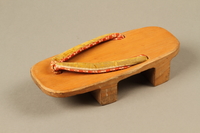
Pair of Japanese geta owned by a Lithuanian Jewish refugee in the Shanghai Ghetto
Object
Pair of wooden geta with fabric thongs acquired by Sara Kupinski’s (later Cohen) family in Kobe, Japan, where her family fled using Japanese and Dutch transit visas supplied by diplomats in Soviet-occupied Kovno, (Kaunas), Lithuania. Sara lived outside of Lida, Poland (now Belarus) with her parents, Eliasz and Slawa, brother, Hirsz, and uncle, Samuel. Following Germany and the Soviet Union’s invasion of Poland in September 1939, Eli and Samuel fled to Vilna (now Vilnius, Lithuania) because they were considered wealthy landowners. Slawa, Hirsz, and Sara later joined them. Having obtained their transit visas in August 1940, Sara’s family left later that year, traveling on the Trans-Siberian railway from Moscow to Vladivostock. In early 1941, they took a boat to Kobe, Japan. That fall, they were forced to go to Japanese-controlled Shanghai. Samuel and Eli found work at a Jewish import and export company, and Sara and Hirsz attended the Jewish school. In early 1943, Japanese authorities ordered that all stateless refugees must live within a designated area, which came to be known as the Shanghai or Hongkew ghetto. In the summer of 1945, following the German surrender in May, US forces bombed Shanghai heavily. On August 14, Japan surrendered to the US. The Kupinski family learned that Slawa’s brothers had survived in France, but that her parents were killed in the Vilna ghetto in 1942 or 1943. Eli’s parents likely died in Siberia. In 1949, the family settled in Toronto, Canada.
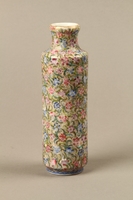
Enameled porcelain vase with a floral pattern owned by Lithuanian Jewish refugee in the Shanghai Ghetto
Object
Colorful, enameled, porcelain vase acquired by Sara Kupinski’s (later Cohen) family in Shanghai, China, where her family fled using Japanese and Dutch transit visas supplied by diplomats in Soviet-occupied Kovno, (Kaunas), Lithuania. Sara lived outside of Lida, Poland (now Belarus) with her parents, Eliasz and Slawa, brother, Hirsz, and uncle, Samuel. Following Germany and the Soviet Union’s invasion of Poland in September 1939, Eli and Samuel fled to Vilna (now Vilnius, Lithuania) because they were considered wealthy landowners. Slawa, Hirsz, and Sara later joined them. Having obtained their transit visas in August 1940, Sara’s family left later that year, traveling on the Trans-Siberian railway from Moscow to Vladivostock. In early 1941, they took a boat to Kobe, Japan. That fall, they were forced to go to Japanese-controlled Shanghai. Samuel and Eli found work at a Jewish import and export company, and Sara and Hirsz attended the Jewish school. In early 1943, Japanese authorities ordered that all stateless refugees must live within a designated area, which came to be known as the Shanghai or Hongkew ghetto. In the summer of 1945, following the German surrender in May, US forces bombed Shanghai heavily. On August 14, Japan surrendered to the US. The Kupinski family learned that Slawa’s brothers had survived in France, but that her parents were killed in the Vilna ghetto in 1942 or 1943. Eli’s parents likely died in Siberia. In 1949, the family settled in Toronto, Canada.
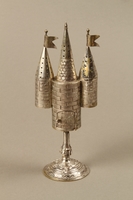
Castle-shaped Havdalah spice box (besamim) owned by a Lithuanian Jewish refugee in the Shanghai Ghetto
Object
Silver alloy, castle-shaped spice box from Poland, carried by Sara Kupinski’s (later Cohen) family as they traveled through the Soviet Union and Japan to China, where her family fled using Japanese and Dutch transit visas supplied by diplomats in Soviet-occupied Kovno, (Kaunas), Lithuania. Later, the box was given to Sara by her mother, Slawa, as a wedding gift in Canada, where the family had settled in 1949. Sara lived outside of Lida, Poland (now Belarus) with her parents, Eliasz and Slawa, brother, Hirsz, and uncle, Samuel. Following Germany and the Soviet Union’s invasion of Poland in September 1939, Eli and Samuel fled to Vilna (now Vilnius, Lithuania) because they were considered wealthy landowners. Slawa, Hirsz, and Sara later joined them. Having obtained their transit visas in August 1940, Sara’s family left later that year, traveling on the Trans-Siberian railway from Moscow to Vladivostock. In early 1941, they took a boat to Kobe, Japan. That fall, they were forced to go to Japanese-controlled Shanghai. Samuel and Eli found work at a Jewish import and export company, and Sara and Hirsz attended the Jewish school. In early 1943, Japanese authorities ordered that all stateless refugees must live within a designated area, which came to be known as the Shanghai or Hongkew ghetto. In the summer of 1945, following the German surrender in May, US forces bombed Shanghai heavily. On August 14, Japan surrendered to the US. The Kupinski family learned that Slawa’s brothers had survived in France, but that her parents were killed in the Vilna ghetto in 1942 or 1943. Eli’s parents likely died in Siberia.
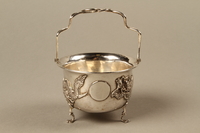
Silver bowl with a dragon owned by a Lithuanian Jewish refugee in the Shanghai Ghetto
Object
Decorative, Zee Sung Silver bowl acquired by Sara Kupinski’s (later Cohen) family in Shanghai, China, where her family fled using Japanese and Dutch transit visas supplied by diplomats in Soviet-occupied Kovno, (Kaunas), Lithuania. Sara lived outside of Lida, Poland (now Belarus) with her parents, Eliasz and Slawa, brother, Hirsz, and uncle, Samuel. Following Germany and the Soviet Union’s invasion of Poland in September 1939, Eli and Samuel fled to Vilna (now Vilnius, Lithuania) because they were considered wealthy landowners. Slawa, Hirsz, and Sara later joined them. Having obtained their transit visas in August 1940, Sara’s family left later that year, traveling on the Trans-Siberian railway from Moscow to Vladivostock. In early 1941, they took a boat to Kobe, Japan. That fall, they were forced to go to Japanese-controlled Shanghai. Samuel and Eli found work at a Jewish import and export company, and Sara and Hirsz attended the Jewish school. In early 1943, Japanese authorities ordered that all stateless refugees must live within a designated area, which came to be known as the Shanghai or Hongkew ghetto. In the summer of 1945, following the German surrender in May, US forces bombed Shanghai heavily. On August 14, Japan surrendered to the US. The Kupinski family learned that Slawa’s brothers had survived in France, but that her parents were killed in the Vilna ghetto in 1942 or 1943. Eli’s parents likely died in Siberia. In 1949, the family settled in Toronto, Canada.
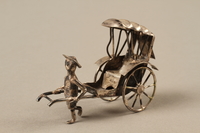
Silver rickshaw and driver figurine owned by a Lithuanian Jewish refugee in the Shanghai Ghetto
Object
Silver rickshaw and runner figurine acquired by Sara Kupinski’s (later Cohen) family in Shanghai, China, where her family fled using Japanese and Dutch transit visas supplied by diplomats in Soviet-occupied Kovno, (Kaunas), Lithuania. Sara lived outside of Lida, Poland (now Belarus) with her parents, Eliasz and Slawa, brother, Hirsz, and uncle, Samuel. Following Germany and the Soviet Union’s invasion of Poland in September 1939, Eli and Samuel fled to Vilna (now Vilnius, Lithuania) because they were considered wealthy landowners. Slawa, Hirsz, and Sara later joined them. Having obtained their transit visas in August 1940, Sara’s family left later that year, traveling on the Trans-Siberian railway from Moscow to Vladivostock. In early 1941, they took a boat to Kobe, Japan. That fall, they were forced to go to Japanese-controlled Shanghai. Samuel and Eli found work at a Jewish import and export company, and Sara and Hirsz attended the Jewish school. In early 1943, Japanese authorities ordered that all stateless refugees must live within a designated area, which came to be known as the Shanghai or Hongkew ghetto. In the summer of 1945, following the German surrender in May, US forces bombed Shanghai heavily. On August 14, Japan surrendered to the US. The Kupinski family learned that Slawa’s brothers had survived in France, but that her parents were killed in the Vilna ghetto in 1942 or 1943. Eli’s parents likely died in Siberia. In 1949, the family settled in Toronto, Canada.
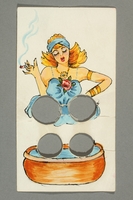
Illustrated postcard with finger holes owned by a Lithuanian Jewish refugee in the Shanghai Ghetto
Object
Hand-illustrated card carried by Sara Kupinski’s (later Cohen) family as they fled from Poland, via Lithuania, the Soviet Union, Japan, and China, during the Holocaust, eventually settling in Canada. They were able to flee by using Japanese and Dutch transit visas supplied by diplomats in Soviet-occupied Kovno (Kaunas), Lithuania. Sara lived outside of Lida, Poland (now Belarus) with her parents, Eliasz and Slawa, brother, Hirsz, and uncle, Samuel. Following Germany and the Soviet Union’s invasion of Poland in September 1939, Eli and Samuel fled to Vilna (now Vilnius, Lithuania) because they were considered wealthy landowners. Slawa, Hirsz, and Sara later joined them. Having obtained their transit visas in August 1940, Sara’s family left later that year, traveling on the Trans-Siberian railway from Moscow to Vladivostock. In early 1941, they took a boat to Kobe, Japan. That fall, they were forced to go to Japanese-controlled Shanghai. Samuel and Eli found work at a Jewish import and export company, and Sara and Hirsz attended the Jewish school. In early 1943, Japanese authorities ordered that all stateless refugees must live within a designated area, which came to be known as the Shanghai or Hongkew ghetto. In the summer of 1945, following the German surrender in May, US forces bombed Shanghai heavily. On August 14, Japan surrendered to the US. The Kupinski family learned that Slawa’s brothers had survived in France, but that her parents were killed in the Vilna ghetto in 1942 or 1943. Eli’s parents likely died in Siberia. In 1949, the family settled in Toronto, Canada.
Sara Kupinski Cohen photograph
Document
Photographic portrait with handwritten caption reading "Rose."



